Ghorepani Poon Hill Trek - 10 Days: A Himalayan Love Affair for Your Soul
Let me tell you about the trek that stole my heart - where every step smells like damp rhododendron petals and every teahouse porch frames mountains so beautiful they'll haunt your dreams. This isn't just a hike; it's a 10-day conversation with the Himalayas, where Annapurna winks at dawn and Gurung grandmothers serve you tea with hands wrinkled like oak bark.
You'll start in Pokhara (where the lakeside beers are cold and the wifi's warm), then wind upward through villages where kids play with yak calves instead of iPhones. The trail? A perfect rhythm of "just challenging enough" - steep stone steps that make your thighs burn, then gentle forest paths where sunlight filters through leaves like liquid gold.
Then comes Poon Hill at 3,210m - where you'll drag yourself up pre-dawn in the dark, questioning your life choices, until suddenly... boom. The sun hits Dhaulagiri's icy fangs and your tired legs forget every complaint. That view? Worth every slippery step and dodgy teahouse toilet.
Let’s talk trail truth - this 10-day dance with the Annapurnas alternates between "why are these stone steps so steep?" grumbles and "holy crap, that’s Dhaulagiri!" gasps. You’ll conquer the infamous 3,800 stone stairs to Ulleri (where your thighs meet their nemesis), then float through old-growth rhododendron forests so thick with pink blooms in spring, you’ll swear you’re hiking through a bridal bouquet. The altitude? Gentle but sneaky - starting at Pokhara’s lazy 820m, peaking at Poon Hill’s 3,210m sunrise showdown, with overnight stops calibrated to let your body adjust while you’re distracted by homemade apple pie in Ghorepani’s teahouses.
The terrain’s a addictive mix:
- Flagstone trails worn smooth by generations of Gurung shepherds
- Suspension bridges that sway over trout-filled rivers (don’t look down if you’re queasy)
- Village approaches where the trail suddenly smells like woodsmoke and simmering garlic
Those "pinch me" moments?
- Waking in Ghorepani to see Fishtail Mountain glowing through your teahouse window
- The golden hour descent into Ghandruk, where every rooftop grows corn and every grandma smiles toothlessly
- Realizing you’ve memorized the Annapurna skyline like an old friend’s face
Key Altitude Checkpoints:
- Tikhedhunga (1,570m): Where you’ll learn to love zigzag trails
- Ghorepani (2,860m): Your cozy basecamp for the sunrise pilgrimage
- Poon Hill (3,210m): The 5AM payoff where the Himalayas stretch forever
The Living, Breathing Magic of the Ghorepani Poon Hill Trail
Let me take you on a journey through one of Nepal's most spectacular natural wonderlands. This isn't just a trek - it's a walking tour through Mother Nature's finest gallery, where every turn reveals new masterpieces. From the moment you leave Nayapul, you'll be immersed in a world where the trees have personalities and the wildlife watches curiously from the shadows.
The Lower Forests: A Sub Tropical Paradise
The adventure begins in lush, humid forests that feel straight out of Jurassic Park. Towering Sal trees create a dense canopy where sunlight filters through in golden shafts. The air smells like damp earth and wild ginger, with the occasional whiff of citrus from unseen fruit trees. Here you'll find:
- Thick stands of bamboo that creak and whisper in the wind
- Vibrant wild orchids clinging to mossy tree trunks
- Dozens of butterfly species fluttering like living confetti
The trailside bursts with edible plants the locals use daily - from tart wild strawberries to medicinal herbs that have been used for generations to cure everything from stomach aches to heartbreak.
The Magic of the Rhododendron Zone
As you climb beyond Ulleri, the forest transforms into something out of a fairy tale. The rhododendrons here aren't the puny garden shrubs you know - they're massive, gnarled trees some over 100 years old. In spring (March-April), the entire mountainside explodes in a riot of red, pink and white blooms so thick they form tunnels of flowers overhead. This is when:
- Langur monkeys play chase through the flowering branches
- Rare Himalayan pheasants strut through the undergrowth
- The air hums with thousands of nectar-drunk bees
The locals call this "lali gurans" season, when the hillsides blush red and village girls weave the flowers into their hair.
The High Country: Where the Wild Things Are
Approaching Ghorepani, the forest changes again to temperate oak and pine. The trees here wear thick coats of lichen and the air carries the crisp scent of pine needles. This is prime wildlife territory where if you're quiet and lucky, you might spot:
- The elusive Himalayan tahr (think mountain goat meets Viking warrior)
- Black bears foraging for berries (they're shy but present)
- Dozens of bird species from tiny sunbirds to massive eagles
At dawn, the forest comes alive with birdsong - a symphony so rich you'll swear there's an orchestra hidden in the trees.
The Little Wonders
What makes this trek truly special are the tiny details most people miss:
- The miniature orchids no bigger than your thumbnail
- The medicinal "pakhanved" plant locals use as natural pain relief
- The ancient "wishing trees" draped in fading prayer flags
- The moss carpets so thick and soft you'll want to nap on them
The Ghorepani Poon Hill Trek: Stone Steps, Mountain Dreams, and Adventures
Let me tell you about the trek that ruined me for all other vacations - where every uphill groan is rewarded with views that punch you right in the feels. This 10-day rollercoaster through Nepal's Annapurna foothills isn't just a hike; it's a love letter to the Himalayas, written in sweat, rhododendron petals, and endless cups of milky chai.
Kathmandu: Where the Adventure Begin
Your story starts in this gloriously chaotic city where:
- Durbar Square's ancient temples compete with buzzing motorbikes for your attention
- The smell of incense and street food slaps you awake better than any alarm clock
- That first bite of steamy momos at a hidden local joint becomes your new core memory
Pokhara: The Calm Before the Climb
After a wild ride through Nepal's countryside (think: hairpin turns with postcard views), you'll hit Phewa Lake - where:
- The Annapurnas play mirror games on still waters at dawn
- Lakeside cafes serve up yak cheese pizzas that hit different after city foodYou'll buy that "I ♡ Nepal" shirt you swore you wouldn't (no judgment)
The Trail That Steals Your Heart (And Tests Your Thighs)
- Nayapul to Tikhedhunga: The Warm-Up
- Your first steps on the trail feel like walking into a living postcard:
- Suspension bridges that sway over turquoise rivers (perfect for dramatic photos)
- Waterfalls that appear out of nowhere like nature's surprise party
- That first teahouse dal bhat that makes you understand why trekkers rave about it
The Infamous Ulleri Stairs
- Let's be real - no one warns you properly about the 3,800 stone steps to Ghorepani. But here's the secret:
- They're brutal but beautiful, winding through enchanted rhododendron forests
- Every rest stop comes with mountain peeks that make the burn worth it
The village kids cheering you on ("Almost there, auntie/uncle!") will melt your heart
Ghorepani Nights & Poon Hill Magic
- Waking up in Ghorepani feels like sleeping inside a mountain postcard:
- Fishtail Mountain glowing right outside your teahouse window
- The cozy chaos of the dining room where trekkers from every corner swap stories
- That 4 AM pilgrimage to Poon Hill's summit where:
- Your breath fogs in the freezing air
- Headlamps snake up the trail like fireflies
- Then...BOOM. The sun hits the Annapurnas and suddenly every sore muscle is forgotten
Ghandruk: Where Mountains Meet Culture
- Descending into this Gurung village feels like stepping into a living museum:
- Stone houses with roofs growing vegetables
- Grandmothers spinning wool like it's 1824
- The local museum where traditional costumes tell stories of mountain life
The Bittersweet Goodbye
When you finally stumble back to Pokhara:
- Your first hot shower in days will feel like a religious experience
- That victory pizza by the lake tastes like pure triumph
- You'll catch yourself staring at the mountains, already plotting your return
Ghorepani Poon Hill Trek: 12 Soul-Stirring Moments You'll Never Forget
Let's cut to the chase - this trek isn't about checking boxes. It's about those heart-stopping, pinch-me moments that sneak up on you when you least expect them. From pre-dawn mountain magic to village encounters that'll restore your faith in humanity, here are the experiences that make this journey truly special:
- Poon Hill Sunrise at 3,210m - Watching the first light ignite Dhaulagiri's icy fangs while sipping steaming chai from a dented thermos
- The 3,800 Stone Stair Challenge to Ulleri - Where your thighs meet their match (but the rhododendron tunnel views make it worth every step)
- Ghorepani's Cozy Teahouse Nights - Playing cards by the fire as Fishtail Mountain glows through frosty windows
- Ghandruk's Living Museum Vibe - Wandering stone alleyways where grandmothers still spin wool on ancient wheels
- Rhododendron Bloom Season (March-April) - Hiking through natural flower tunnels so pink they look Photoshopped
- Suspension Bridge Adventures - Those wobbly crossings over the Modi Khola's turquoise rapids
- Tikhedhunga's Waterfall Welcome - Your first trailside shower from a hidden cascade
- The "Real" Nepali Breakfast - Gurung bread with local honey at a family-run teahouse
- Tadapani's Monkey Business - Langurs performing acrobatics in old-growth oak trees
- Pokhara's Victory Pizza - That first cheesy bite after days of dal bhat
- Ulleri Kids' Cheer Squad - Local children shouting encouragement ("Almost there, auntie!")
- The Final Morning Feels - That bittersweet last glimpse of Annapurna from the bus window
The Best Time to Trek Ghorepani Poon Hill: A Season-by-Season Breakdown
This isn’t just about picking dates—it’s about matching Nepal’s ever-changing moods to your dream trekking experience. Whether you crave flower-filled trails, crystal-clear mountain views, or off-season solitude, here’s the real scoop on when to tackle those famous stone steps to Poon Hill.
1. Autumn (October–November) – When Nepal Shows Off
If the Himalayas had a red-carpet season, this would be it. Post-monsoon skies are so clear you’ll swear someone polished them, making Poon Hill’s sunrise views razor-sharp. Days are warm (15–20°C), nights crisp but not cruel, and the trails? Packed with fellow trekkers swapping stories.
Why it’s perfect:
- Unbeatable visibility – Annapurna and Dhaulagiri look close enough to touch
- Festival fever – Dashain and Tihar celebrations mean villages are draped in marigolds
- Ideal temperatures – No sweaty climbs or frozen toes
Watch for:
- Peak crowds at Poon Hill sunrise (arrive 30 mins early to claim your spot)
- Book teahouses ahead – Ghorepani fills up fast
2. Spring (March–April) – Nature’s Grand Reopening
Imagine hiking through tunnels of hot-pink rhododendrons so thick they blot out the sky. That’s spring here. Days are longer, temps hover at a sweet 18–25°C, and the hillsides explode with wildflowers.
Why it’s magic:
- Rhododendron blooms ("lali gurans" season) turn trails into fairy tales
- Fewer crowds than autumn but equally great visibility
- Baby animals! Spot playful langurs and pheasant chicks
Watch for:
- Late April haze can soften distant peaks
- Warmer days mean earlier starts to beat the heat
3. Winter (December–February) – For the Frosty & Fearless
Trade crowds for pristine snow-dusted trails and teahouses all to yourself. While mornings at Poon Hill (‑5 to 5°C) require serious layers, the crisp air makes mountain views even sharper.
Why it’s underrated:
- Empty trails – You’ll have sunrise viewpoints to yourself
- Snow-kissed peaks – Annapurna wears her winter diamonds
- Cozy teahouse vibes – More blankets, more chai, more firepit stories
Watch for:
- Icy stone steps near Ghorepani (microspikes help)
- Shorter days – Finish hiking by 4 PM
4. Monsoon (June–September) – The Adventurous Gamble
Only for those who love moody mist and emerald landscapes. While rain showers are daily (and leeches lurk), the valleys glow unreal green, waterfalls thunder, and you’ll have the trail 90% to yourself.
Why some love it:
- Lush, quiet, and cheap – Teahouse deals abound
- Dramatic clouds playing peekaboo with peaks
- Rice terraces at their most vibrant
Watch for:
- Slippery trails – Trekking poles are lifesavers
- Cloudy viewpoints – Poon Hill sunrise is 50/50
Ghorepani Poon Hill Trek: Teahouse Feasts & Mountain Nesting Spots
Let’s talk about the real trekking essentials—steaming plates of dal bhat, cozy teahouse bunk beds, and those unexpected moments of luxury that make you go, "Wait, we’re in the mountains?!" This isn’t just about surviving the trail—it’s about thriving on it, with full bellies and warm beds waiting at every stop.
🏡 Teahouse Living: Your Himalayan Home Away From Home
The Basics: What to Expect
Ghorepani Poon Hill’s teahouses are Nepal’s version of mountain inns—rustic but surprisingly comfy. Think:
- Twin beds with thick blankets (no heated rooms, but you’ll sleep like a baby after those uphill climbs)
- Communal dining halls with crackling stoves—where trekkers bond over card games and chai
- Solar-powered charging (yes, you can Instagram that sunrise)
- Shared bathrooms (hot showers cost extra, but oh, the bliss!)
(Pro Tip: Bring a sleeping bag liner—while blankets are provided, nights get chilly at 2,850m in Ghorepani.)
Luxury Touches in Ghorepani Village
Surprise! Some teahouses here offer "deluxe" upgrades:
- Private rooms with en suite toilets
- Glass-walled dining rooms where Fishtail Mountain joins you for breakfast
- Bakeries selling fresh apple pie (yes, really—thank the British trekkers of the ‘70s)
🍽️ Food on the Trail: From Dal Bhat to Surprise Pizza
The Staples: Fuel for Those Stone Steps
Every teahouse menu reads like a "Greatest Hits of Nepal" album:
- Dal Bhat Power 24/7 – Unlimited refills of lentil soup, rice, and veggie curries (trekker legend says it gives you superhuman climbing abilities)
- Gurung Bread – Fluffy, fried, and best dunked in local honey
- Tibetan Momos – Dumplings that taste even better when eaten with mountain views
Unexpected Delights
Some teahouses get creative:
- Yak Cheese Pizza in Tadapani (the highest pizza delivery you’ll ever experience)
- Garlic Soup – A local remedy for altitude adjustment (and vampire prevention)
- Fresh Buckwheat Pancakes – Made from flour ground in village watermills
(Pro Tip: Carry small bills—remote teahouses rarely have change for your 1,000 NPR notes.)
💎 Hidden Luxuries (Yes, Really!)
- Ghorepani’s Secret Bakery – Where German trekkers taught locals to bake black forest cake at 2,850m
- Sunrise Room Service – Some teahouses deliver bed tea before your Poon Hill climb
- The "VIP" Toilet Experience – A few spots now have Western toilets (bring your own TP though)
Ghorepani Poon Hill Trek Permits: Cutting Through the Red Tape
Let’s be real – nobody dreams about paperwork when imagining their Himalayan adventure. But here’s the good news: the Ghorepani Poon Hill trek keeps bureaucracy refreshingly simple. No obscure permits, no waiting in dusty offices – just two straightforward passes that fund trail maintenance and local communities. Here’s exactly what you need (and more importantly, what you don’t need) to hit those famous stone steps.
The Only 2 Permits You Actually Need
1. Annapurna Conservation Area Permit (ACAP)
- What it is: Your ticket to trek through Nepal’s most biodiverse region
- Cost: $30 USD (NPR 3,000) for foreigners
Where to get it:
- Kathmandu: Nepal Tourism Board office in Bhrikuti Mandap
- Pokhara: ACAP counter at the Tourism Board office near Lakeside
- On the spot: Nayapul checkpoint (but why risk delays?)
- Why it matters: Funds conservation efforts and maintains trails you’ll be hiking
(Pro Tip: Get this in Kathmandu or Pokhara before your trek – the Nayapul office sometimes runs out of receipt paper (yes, really).)
2. Trekkers’ Information Management System (TIMS) Card
- What it is: A safety tracking system (not actually a physical "card" anymore)
- Cost: $20 USD (NPR 2,000) for independent trekkers, FREE if with a licensed guide
- Where to get it: Same offices as ACAP
- Key Detail: If you booked through a local operator, they handle this digitally
What You Won’t Need (Breathe Easy)
- Restricted Area Permit (RAP): Only for zones like Upper Mustang
- Garbage Deposit: Some treks require this – not here
- Special Passes: No additional fees for Poon Hill sunrise
The Stress-Free Permit Process
- Before You Go: Email your operator a passport scan (if using a guide)
- Kathmandu/Pokhara: Pop into the tourism office (takes 20 mins max)
- On Trail: Keep permits handy for occasional checkpoints (but no one will ruin your sunrise vibe)
(Pro Move: Snap photos of your permits as backup – teahouse owners sometimes ask to see them.)
Why This is Easier Than Everest Treks
- No advance applications – Walk in, walk out with permits
- No peak season quotas – Available year-round
- No guide mandate – Solo trekking is allowed (but guides make life easier)
Ghorepani Poon Hill Trek: The Honest Truth About Fitness & Difficulty
Let’s cut through the brochure speak – this trek won’t require Olympic-level fitness, but those 3,800 stone steps to Ulleri don’t climb themselves either. The Ghorepani Poon Hill route is Nepal’s perfect "starter" Himalayan adventure, designed to thrill rather than break you. Here’s exactly what your body’s in for, from those first gentle trails to the triumphant Poon Hill sunrise.
The Daily Grind (That Feels Anything But)
Most days serve up 4-6 hours of walking at a Nepal "bistari" (slowly) pace, covering 8-12 km with elevation gains of 500-800m. The trail serves a mixed bag of terrain – packed dirt paths through rhododendron forests, the infamous Ulleri stairmaster-from-hell section, and occasional slippery descents where trekking poles earn their keep. While the altitude maxes out at a very manageable 3,210m (Poon Hill), the cumulative effect of consecutive climbing days surprises many first-timers. Your quads will announce their presence loudly by day three.
Who’s This Trek Really For?
This route plays nice with:
- Weekend hikers who can handle 5-hour Saturday hill walks
- Gym regulars comfortable with stair climber sessions
- Active travelers who don’t balk at walking 15,000+ steps daily
The secret sauce? It’s more about endurance than brute strength. I’ve seen wiry grandmas outpace muscular gym bros because they trained smart – steady cardio trumps bench presses here.
The Altitude Advantage
Unlike Everest treks where AMS is a real concern, Poon Hill’s modest elevation means most experience just mild huffing-and-puffing. The itinerary naturally acclimatizes you – starting at Pokhara’s 820m, spending nights at progressively higher teahouses, with no single day’s climb exceeding 1,000m gain. That said, don’t underestimate how those thinner-air final climbs to Ghorepani (2,850m) might leave you breathless after the simplest tasks (like tying your boots).
Training That Actually Helps
Forget fancy gear – your best prep is:
- Stair repeats (with a loaded daypack) until your legs stop complaining
- 2-hour weekend hikes on uneven terrain to condition ankles and knees
- Core work (planks, bird-dogs) for balance on those rocky descents
- Local guides swear by the "30-minute test" – if you can briskly walk uphill for 30 minutes without stopping, you’ve got the baseline fitness.
When to Worry (And When Not To)
The trek’s one real physical challenge comes on day two – the notorious Ulleri staircase (3,800 steps gaining 600m elevation). It’s less about technical difficulty and more about mental stamina. Most groups take 3-4 hours with frequent chai breaks. Pro tip: Train calves specifically – those who do report 50% less next-day soreness.
The Emotional Fitness Factor
Nobody warns you about the psychological game:
- Patience with Nepal’s "bistari bistari" (slowly slowly) pace
- Humility when village kids scamper past your struggling self
- Resilience when rain soaks your gear on day three
(The good news? Every teahouse becomes an instant support group where trekkers bond over shared exhaustion and that magical first sip of post-hike ginger tea.)
Looking to save a day without missing the highlights? Our Ghorepani Poon Hill Trek – 9 Days delivers the iconic sunrise views and charming village experience in a streamlined, time-smart package.
🧭 Alternative Tours & Packages
- Ghorepani Poon Hill Trek
A compact and well-paced itinerary ideal for those seeking a moderate trek through scenic trails and traditional villages, culminating in the famous sunrise view from Poon Hill.
- Mardi Himal Trek
A less-traveled trail that offers serene mountain landscapes and stunning close-up views of Machapuchare, this trek is perfect for those looking to escape the crowds.
- Mardi Himal Trek – Annapurna’s Hidden Gem Adventure
Journey through peaceful forested trails and high ridges with panoramic Himalayan vistas on this off-the-beaten-path trek in the Annapurna region.
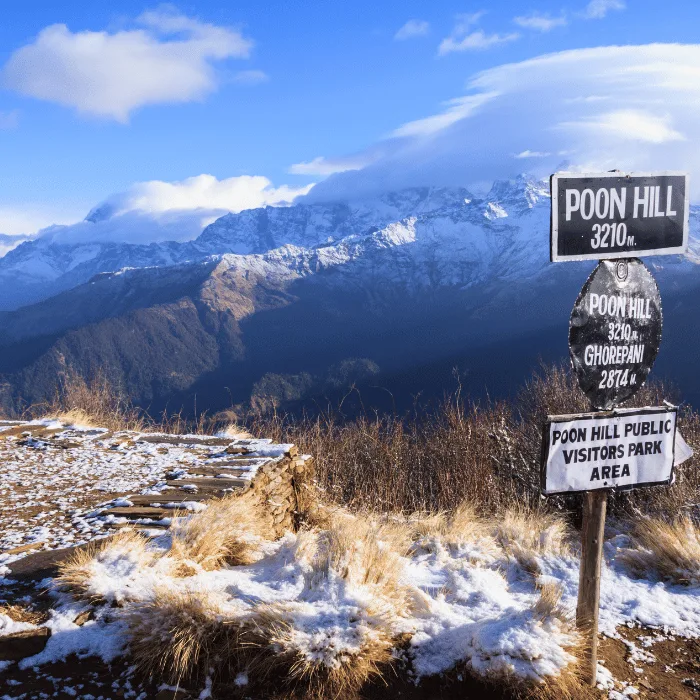
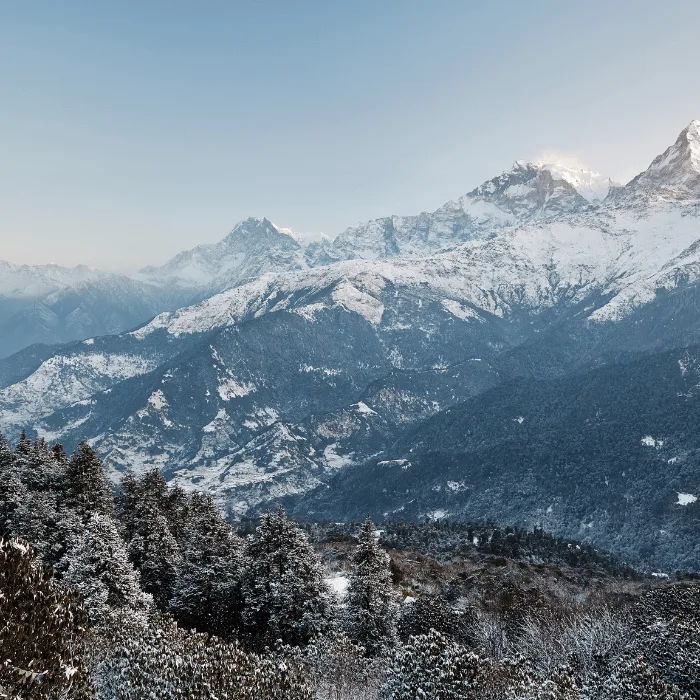
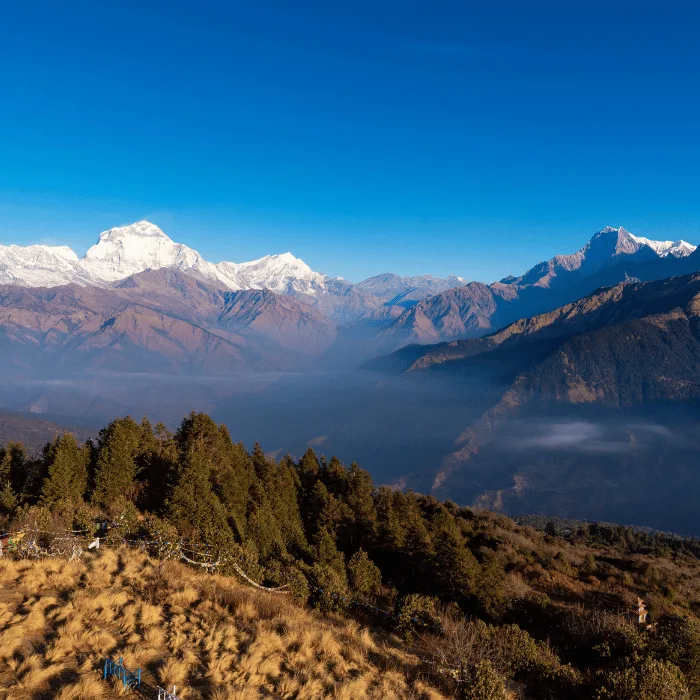
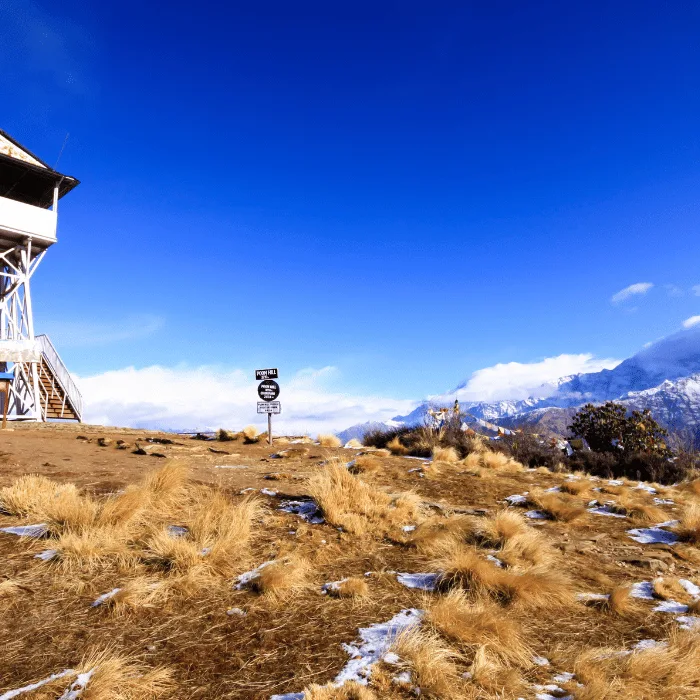
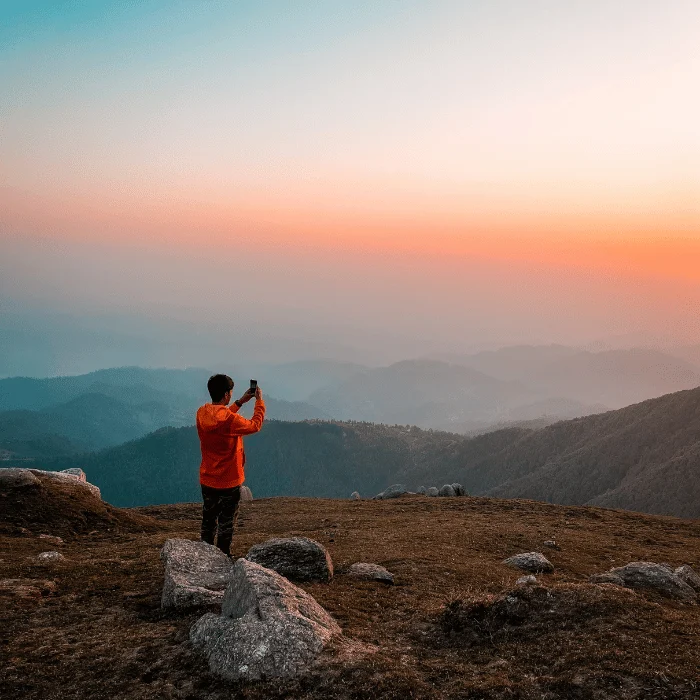


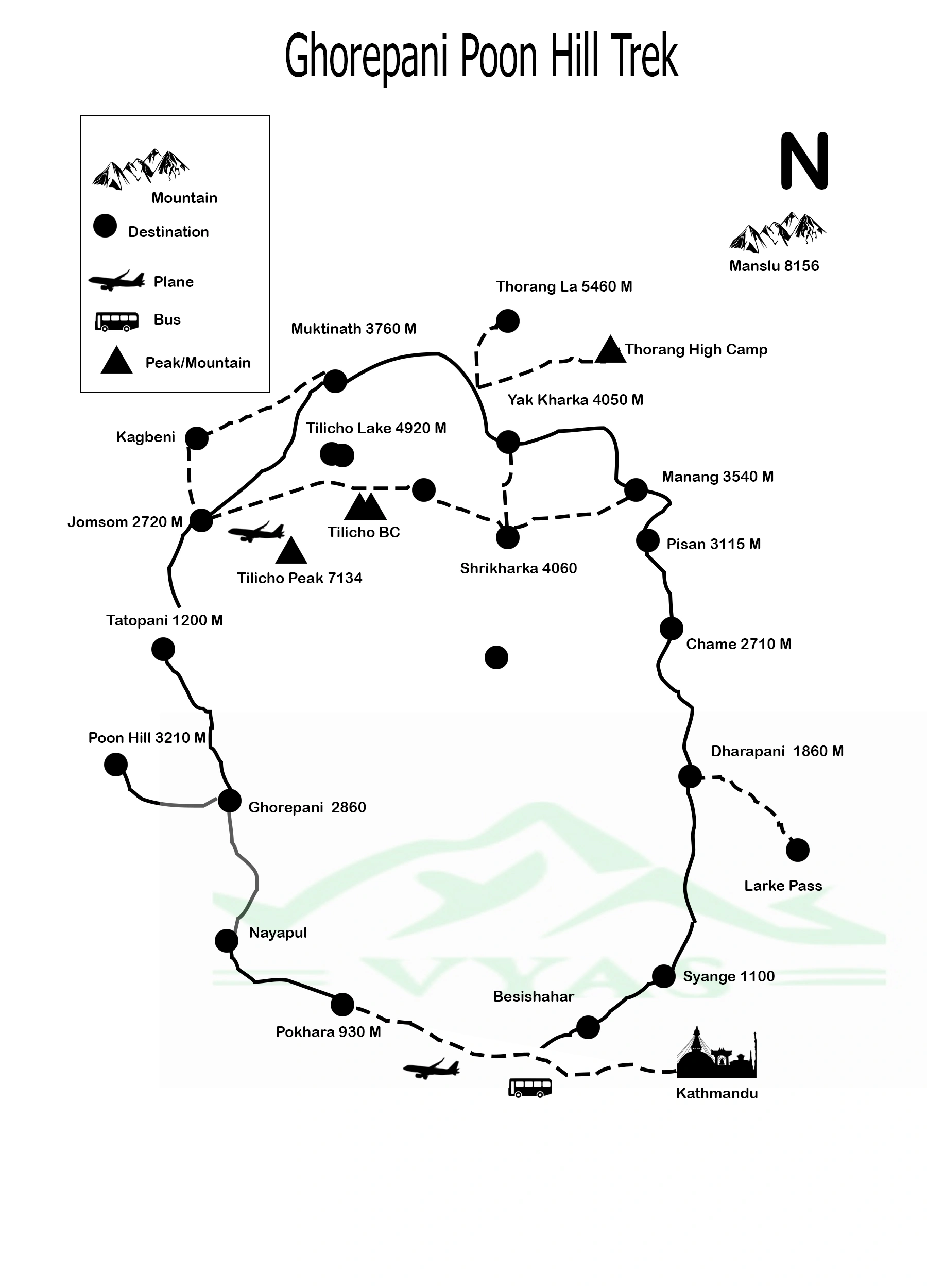






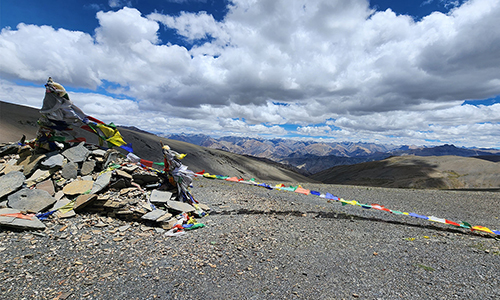

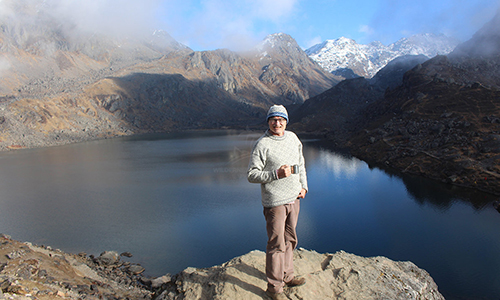


Natalie Brown
2025-06-16 15:09:55
The 10-day Ghorepani Poon Hill Trek was the perfect introduction to the Himalayas! The sunrise view from Poon Hill was absolutely magical. The trail passed through charming villages and rhododendron forests. Vyas Trek Nepal organized everything with care — from accommodations to our wonderful guide. Highly recommended for nature lovers!